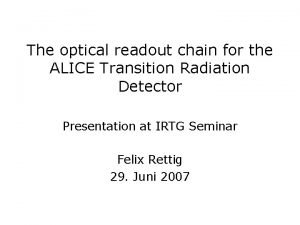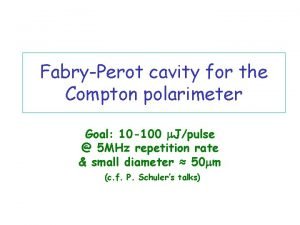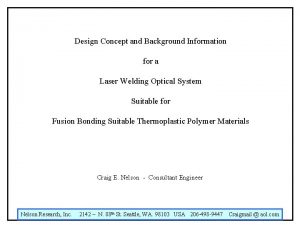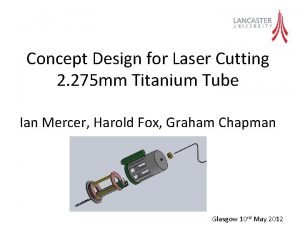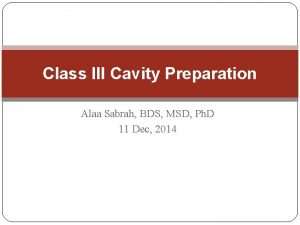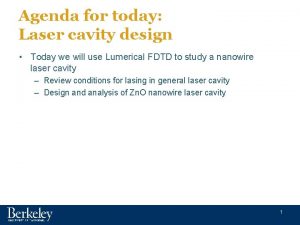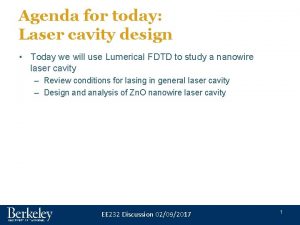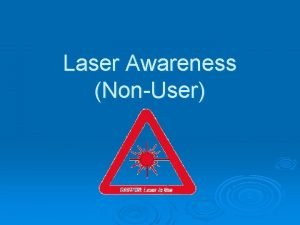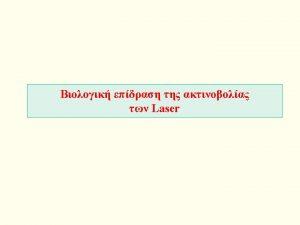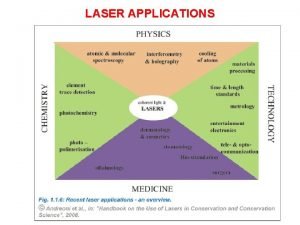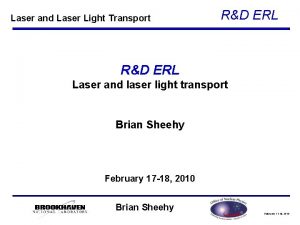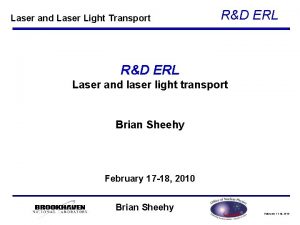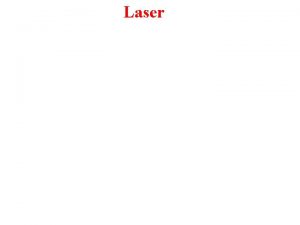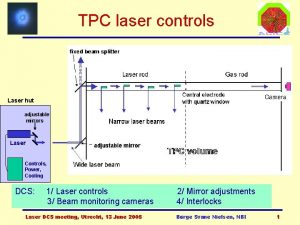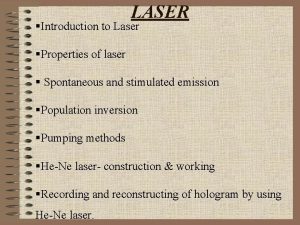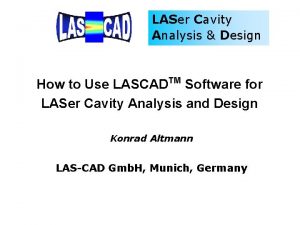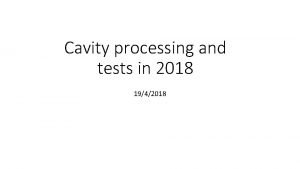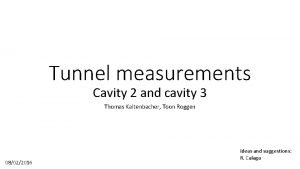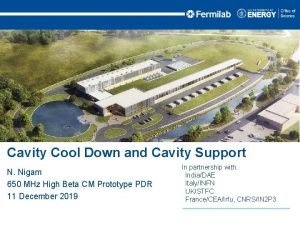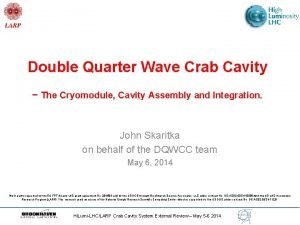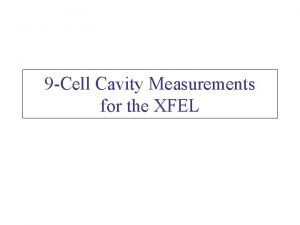Agenda for today Laser cavity design Today we






















- Slides: 22

Agenda for today: Laser cavity design • Today we will use Lumerical FDTD to study a nanowire laser cavity – Review conditions for lasing in general laser cavity – Design and analysis of Zn. O nanowire laser cavity EE 232 Discussion 02/09/2017 1

Review: basic laser concepts EE 232 Discussion 02/09/2017 2

Review: basic laser concepts EE 232 Discussion 02/09/2017 3

Zn. O nanowire laser cavity • As an interesting case study, let’s examine a somewhat exotic laser cavity consisting of a Zn. O nanowire laser cavity • “Bottom-up” fabricated Zn. O nanowires grown on sapphire substrate • Cavity is formed by mirror between top facet and air and bottom facet and sapphire substrate • How much gain do we need to observe lasing in such a cavity? Huang, Michael H. , et al. "Room-temperature ultraviolet nanowire nanolasers. " science 292. 5523 (2001): 1897 -1899. EE 232 Discussion 02/09/2017 4

Back-of-the envelope calculation of threshold gain for Zn. O nanowire Mirror #1 Zn. O nanowire (n = 2. 45) Mirror #2 Sapphire (n = 1. 8) EE 232 Discussion 02/09/2017 5

Back-of-the envelope calculation of threshold gain for Zn. O nanowire Mirror #1 Assume nanowire length is 10 µm, confinement factor is unity, and negligible internal loss Zn. O nanowire (n = 2. 45) Mirror #2 Sapphire (n = 1. 8) (this is pretty high!) EE 232 Discussion 02/09/2017 6

Lumerical simulation • Let’s use Lumerical FDTD to get a more accurate value for the mirror reflectivity and confinement factor to determine threshold gain • We could simulate the entire structure and determine the Q-factor to get the threshold gain however it’s faster to simply simulate the mirror reflectivity for each mirror and use the expression on the previous page EE 232 Discussion 02/09/2017 7

FDTD procedure (1) Launch waveguide mode (3) Monitor reflected power with a field monitor (2) Guided mode will reflect off the mirror. Some light will radiate away but some will reflect in the backward direction reflected light radiated light EE 232 Discussion 02/09/2017 8

Guided mode source • Open the file Zn. O_nanowire_laser_mirror. fsp • This file contains the geometry necessary to simulate reflectivity from both mirrors of the Zn. O nanowire cavity – Zn. O has hexagonal cross-section with 130 nm diameter • We will assume lasing occurs at the Zn. O bangap wavelength of 370 nm and therefore center our simulation range at that wavelength EE 232 Discussion 02/09/2017 9

Computational domain PML air nanowire Mode source Power monitor Movie monitor EE 232 Discussion 02/09/2017 10

Mode source EE 232 Discussion 02/09/2017 12

Mode source EE 232 Discussion 02/09/2017 13

Plotting mirror reflectivity • Run simulation (if not already) • Right-click reflection. Monitor and select Visualize T • This will plot the percentage of power transmitted through the field-monitor. That is it will tell us much power was reflected from the nanowire laser cavity mirror (i. e. reflectivity) EE 232 Discussion 02/09/2017 16

Zn. O-Air mirror reflectivity 11% reflectivity EE 232 Discussion 02/09/2017 17

Zn. O-Air mirror reflectivity • We measure a reflectivity of 11%. This is slightly lower than our back-of-the-envelope calculation of 18%. • Why? EE 232 Discussion 02/09/2017 18

Zn. O-Sapphire reflectivity • Next, we need to simulate the reflectivity of the other mirror. • Click on Layout (where the Run button was) to go back to Layout mode • Right-click on sapphire in the objects tree and click on enable. • Re-run simulation and plot the reflectivity. EE 232 Discussion 02/09/2017 19

Zn. O-Sapphire reflectivity 0. 7% reflectivity EE 232 Discussion 02/09/2017 20

Confinement factor • EE 232 Discussion 02/09/2017 21

Confinement factor calculation EE 232 Discussion 02/09/2017 22

Confinement factor calculation confinement factor EE 232 Discussion 02/09/2017 23

Confinement factor calculation • We are limited to a circular or rectangular geometry when calculating confinement factor. When waveguide has more complicated geometry (such as Zn. O nanowire with hexagonal cross-section) we may wish to more rigorously determine confinement factor by writing a Lumerical script. EE 232 Discussion 02/09/2017 24

Threshold gain calculation • Now, let’s recalculate threshold gain calculation with our more accurate values for mirror reflectivity and confinement factor. Assume nanowire length is 10 µm, and negligible internal loss EE 232 Discussion 02/09/2017 25
 Thoracic membranes and cavities
Thoracic membranes and cavities Felix rettig
Felix rettig Laser cavity
Laser cavity Body planes directions and cavities
Body planes directions and cavities Abdominopelvic cavity location
Abdominopelvic cavity location Peritoneal cavity meaning
Peritoneal cavity meaning Abdominal cavity
Abdominal cavity Agenda sistemica y agenda institucional
Agenda sistemica y agenda institucional Agenda for today
Agenda for today Laser design concept
Laser design concept Laser design concept
Laser design concept For todays meeting
For todays meeting There is class today
There is class today Proposal kickoff meeting agenda
Proposal kickoff meeting agenda Characteristic of fingerprint
Characteristic of fingerprint Today's lesson or today lesson
Today's lesson or today lesson Example of repitition
Example of repitition Isthmus in cavity design
Isthmus in cavity design Bevel in class 3 composite
Bevel in class 3 composite Axial wall depth in class 2 amalgam
Axial wall depth in class 2 amalgam Class 3 cavity
Class 3 cavity Fspos vägledning för kontinuitetshantering
Fspos vägledning för kontinuitetshantering Novell typiska drag
Novell typiska drag

